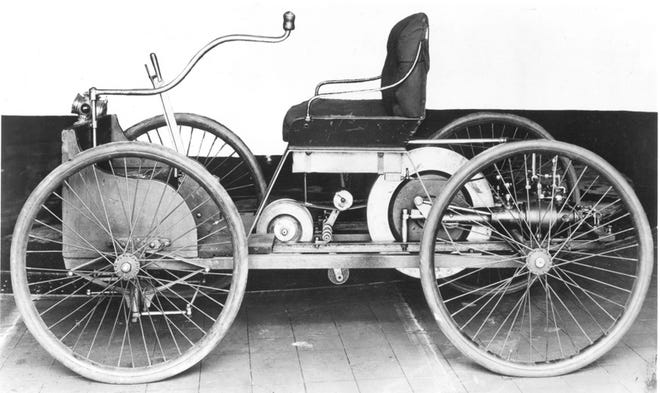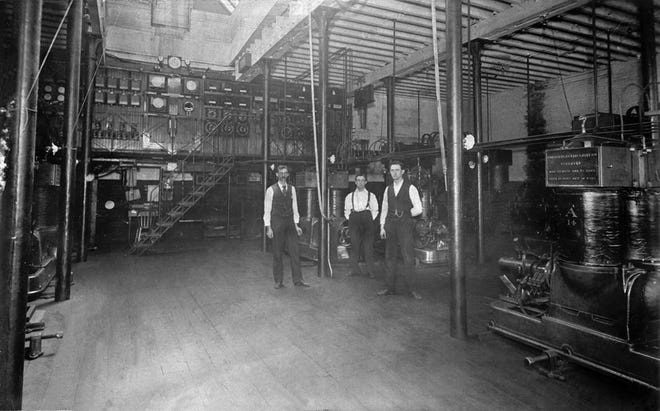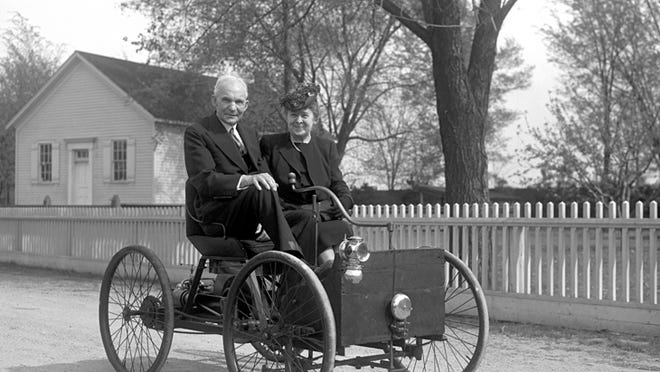On this date 125 years ago, Henry Ford finished building his first four-wheeled vehicle and drove it on the streets of Detroit. It was called the Quadricycle.
“And the rest, as they say, is history,” wrote a Ford retiree to the Free Press on Friday.
In the early morning of June 4, 1896, just before his 33rd birthday, Henry Ford made his first trial run in the small vehicle. It was 45 inches wide and 43 inches high.
Neighbors referred to Ford as a young man with “wheels in his head,” because he could understand the relationship between all the car parts, according to a piece written this week by Leslie Armbruster, the Ford archives manager.

Henry Ford was the eldest of six children, the son of an Irishman who came to America in 1847 from County Cork, Ireland.
By the time Ford was 12, he spent much of his spare time in a small machine shop he had equipped himself. At 15, he constructed his first steam engine, according to his biography.
He went to work as a machinist’s apprentice at James F. Flower and Brothers Machine Shop in Detroit, shaping brass valves on a milling machine, according to PBS. After completing his training in 1882, he spent a year working on Westinghouse steam engines in southern Michigan.

Ford went to work at the Edison Illuminating Company of Detroit as an engineer In July 1891, according to his biography. He became chief engineer on November 6, 1893. Thomas Edison would become a lifelong mentor and friend.
In the early 1890s, Henry Ford tinkered in a workshop in the back of his home at 58 Bagley Ave. in Detroit, not far from the Edison plant. He was raising eyebrows in the neighborhood, and not in a good way.
“At that time, any man experimenting with ‘horseless carriages’ was considered something of an oddity,” Armbruster wrote.
More:‘First pour like this’: 250 truckloads of concrete at Michigan Central Station
Building a motor didn’t come easy to Ford, whose first motor “sputtered into history on Christmas Eve in 1893,” the year his son Edsel Bryan Ford was born, records show.

He began working on a motor for his Quadricycle in January 1896, later building the chassis and body of the carriage, Armbruster wrote, based on historical documents.
“In the months before the Quadricycle was finished, he worked night after night until midnight or later, and all day and night Saturdays,” Armbruster wrote.

Ford would tell people that results always come to those who work hard enough.
According to the archives:
“Apart from the motor, wheels, axles and steering tiller, the vehicle was constructed of wood, and weighed only 500 pounds, without fuel. It had a buggy-like seat and ran on bicycle-size wheels with pneumatic tires. Ford’s ‘horseless carriage’ had two speeds — 10 and 20 miles per hour selected by twin drive belts. It had a neutral gear but no reverse. Gear changes were made by a clutch lever mounted on the floor to the right of the driver. Final drive was by a single chain. There were no brakes, but Ford included a doorbell as a horn.
After realizing his Quadricycle was wider than the garage door, he broke out the door frame and bricks with an ax and rolled the vehicle into the alley, Armbruster wrote.
“With his wife and a helper, Jim Bishop, anxiously watching, Ford put the clutch in neutral and spun the flywheel. The motor came to life! Ford drove the Quadricycle slowly along nearby Detroit streets, with Bishop on a bicycle ahead of him and a few curious passers-by staring incredulously
More:Bill Ford describes his future, role of daughter as first female Ford family member on board
More:Sold! Ford family station wagon gets record price at auction while 1966 Shelby Cobra doesn’t
Over the next few months, Ford replaced wooden parts with metal, installed a cooling system in the engine, and fitted sturdier wheels.
Henry Ford sold the Quadricycle for $200, and it still survives today in a permanent display at The Henry Ford museum in Dearborn, Michigan.
“When Henry Ford took the Quadricycle for that early morning drive on June 4, 1896, I think he realized even then that the short trip would change the course of his own life. But he couldn’t have known that it was also the start of profound changes in mobility and manufacturing,” said Matt Anderson, transportation curator at The Henry Ford.

The primitive vehicle eventually led to the Model A, said Ted Ryan, Ford archives and heritage brand manager.
Ford Motor Co. was officially incorporated seven years later on June 16, 1903, when founder Henry Ford launched his venture in a converted factory on Mack Avenue in Detroit.
More:Ford CEO Jim Farley is doing important work at TCF Center — and few know it
More:Ford makes come-from-behind push with Mach-E as industry enters new era
Contact Phoebe Wall Howard: 313-222-6512 orphoward@freepress.com.Follow her on Twitter@phoebesaid. Read more on Ford and sign up for our autos newsletter.
